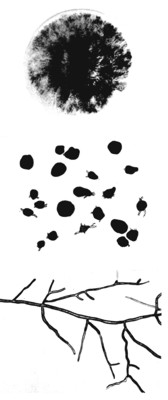Diseases
Macrophomina phaseolina (Tassi) Goid. - Charcoal Root Rot of Cotton.
Systematic position.
Kingdom Fungi, phylum Ascomycota, class Ascomycetes, genus Macrophomina.Synonyms.
Sclerotium bataticola Taubenh.; Macrophomina phaseoli (Maubl.); Tiarosporella phaseoli (Maubl.); Rizoctonia bataticola (Taubenh.); Rhizoctonia lamellifera W. Small.Biological group.
Saprotroph.Morphology and biology.
The causative agent of Charcoal Root Rot of Cotton is the fungus Macrophomina phaseolina developing during its life cycle in anamorphous stage; black pycnidia are formed under epidermis. The sterile mycelium stage (Rhizoctonia bataticola) is also present in the cycle of its development. Morphological structures of the pathogen include conidia (pycnospores) on very short threadlike conidiophores, septate vegetative mycelium, and black (charcoal) fine sclerotia, 50 mkm to 1 mm long. The disease can appear on cotton at its early development stages, but its symptoms basically accrues right after flowering and later in form of radical or root rots. Deep necrosis appears on the affected parts, reaching vascular system and central tissues. The root tissue lags behind or falls off as a result. Numerous fine sclerotia appear on affected tissue, which appears strewed with coal. At the disease intensive development, sudden withering of cotton plants occurs, but the leaves do not fall down for a long time. Fungus M. phaseolina affects many field cultures and wild plants. Sources of the pathogen infection are sclerotia in soil and affected vegetation residues and weeds.Distribution.
The disease is distributed in southern parts of Central Asian countries of the former USSR, in some places of Tajikistan and Turkmenistan.Ecology.
The fungus M. phaseolina is a soilborn pathogen. It is very thermophilic. The disease causative agent affects cotton at high humidity and air temperature in the limits 30-37°C. Sclerotia of the fungus can keep its viability at -38°C.Economic significance.
The disease causes thinning of sowings and withering of plants which results in large cotton yield losses. Control measures are crop rotation including alternation with cereals and unaffected crops, application of the biological preparation of Trichoderma, presowing seed treatment, duly weed control in crops before closing plants in rows.Reference citations:
CABI Bioscience Databases. 2004. http://www.SpeciesFungorum.org .Gorlenko M.V. 1968. Agricultural phytopathology. Moscow: Visshaya Shkola, 169 p. (in Russian).
Gorlenko M.V. 1976. Order Sterile myceliums (Mycelia sterilia or Agonomycetales). In: Gorlenko M.V. ed., Life of plants. Fungi. Vol. 2. Moscow: Prosveshchenie, 438 p. (in Russian).
Khokhryakov M.K., Dobrozrakova T.L., Stepanov K.M., Letov M.F. 1966. Key to plant diseases. In: M.K. Khokhryakov, ed. Leningrad: Kolos, 352 p. (in Russian).
Novotelnova N.S. 2005. Diseases of cotton. In: Pavlyushin V.A., ed. Diseases of cultural plants. Saint-Petersburg: ICZR of VIZR, p. 81-84 (in Russian).
Pidoplichko N.M. 1978. Fungi are parasites of cultural plants. In: Key. Vol.2, Kiev: Naukova Dumka, p. 61-63 (in Russian).


